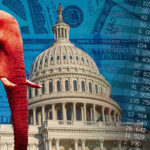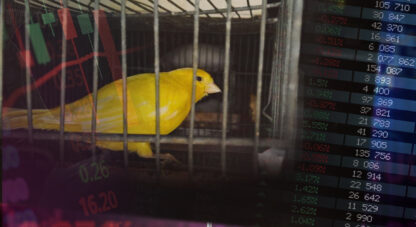The Dow (DJIA) jumped 545 points (2.1%) in Wednesday’s post-midterms trading. The S&P500’s 2.1% rise was overshadowed by the Nasdaq Comp’s 2.6% and the Nasdaq100’s 3.1% advances. Healthcare stocks surged, with the S&P500 Healthcare Index up 2.9% (Healthcare Supplies index jumping 4.5%). Led by Amazon’s 6.9% (113 points!) surge, the S&P Internet Retail Index gained 6.1%. From October 29th trading lows to Thursday’s highs, the S&P500 rallied 8.1% and the Nasdaq100 jumped 9.6%.
The post-election bullish battle cry was a resolute “back to fundamentals!” With the market surging, analysts were proclaiming “reduced uncertainty” and “the best possible outcome for the markets.” The President and Nancy Pelosi both adopted restrained tones and spoke of efforts to cooperate on important bipartisan legislation. Prospects for a market-pleasing infrastructure spending bill have improved. What’s more, a positive spin was put on the return of Washington gridlock. Less Treasury issuance would support lower market yields generally, ensuring the U.S. economic expansion maintains ample room to run. The weaker post-election dollar was said to be constructive for global liquidity.
The EEM emerging market ETF rose 1.9% Wednesday, pushing the rally from October 29th lows to 11.0%. The South African rand and Indonesian rupiah gained 1.5%, as most EM currencies temporarily benefited from the weaker dollar.
Wednesday provided a good example of news and analysis following market direction. Stocks were up, so election results must have been positive. I would tend to see Wednesday trading as heavily impacted by the unwind of hedges – and yet another short squeeze. After trading as high as 20.6 in Tuesday trading, the VIX (equities volatility) index ended Wednesday’s session at 16.36, an almost one-month low.
Market weakness in the weeks leading up to the midterms created an unusual backdrop. A pivotal election combined with a vulnerable market backdrop ensured a double-dose of hedging activity heading into Tuesday. And with the election having avoided “tail risk” outcomes (blue wave with Democratic control of both houses, or Republicans maintaining full control), post-election trading saw a significant reversal of risk hedges and bearish speculations.
It did not, however, take long for the joyful “gridlock is good” rally to face a reality check. The President’s tweet: “If the Democrats think they are going to waste Taxpayer Money investigating us at the House level, then we will likewise be forced to consider investigating them for all of the leaks of Classified Information, and much else, at the Senate level. Two can play that game!” NYT: “Jeff Sessions is Forced Out as Attorney General as Trump Installs Loyalist.” And then came Friday’s (post-election) barbs from the director of the White House’s National Trade Council:
November 9 – Bloomberg (Andrew Mayeda and Shawn Donnan): “White House trade adviser Peter Navarro warned Wall Street bankers and hedge-fund managers to back down from their push for President Donald Trump to strike a quick trade deal with China’s Xi Jinping. ‘As part of a Chinese government influence operation, these globalist billionaires are putting a full-court press on the White House in advance of the G-20 in Argentina,’ Navarro said… Their mission is to ‘pressure this President into some kind of deal’ but instead they’re weakening his negotiating position and ‘no good can come of this.’ Navarro said investors should be re-directing their ‘billions’ of dollars into helping rebuild areas hit by manufacturing job losses. ‘Wall Street, get out of those negotiations. Bring your Goldman Sachs money to Dayton, Ohio, and invest in America.’”
As another extraordinary market week came to its conclusion, the bulls “Back to Fundamentals” mantra from Wednesday was being hijacked by the bear camp. From my analytical perspective, the outcome of the midterms wasn’t going to materially alter the Bursting Global Bubble Thesis. Global financial conditions continue to tighten. Very serious issues associated with China’s faltering Bubble remain unresolved. Italy’s political, financial and economic problems won’t be disentangled anytime soon. And the midterms weren’t going to solve the more pressing issues in the U.S., certainly including inflated asset and speculative Bubbles and a Federal Reserve determined to stay on a policy normalization course.
November 8 – Wall Street Journal (Justin Lahart): “Anybody who thought the Federal Reserve might scale back its plans for future rate increases after all the recent turmoil in the stock market has to be disappointed. The Fed on Thursday left interest rates unchanged, and it didn’t change much else. The statement it put out following its two-day meeting contained only minor tweaks from its September statement. It noted that the unemployment rate had declined since its September meeting (as opposed to ‘stayed low’), and that business investment has ‘moderated from its rapid pace earlier in the year’ (rather than ‘grown strongly’). The two things roughly offset each other and both have been clear from the data.”
WSJ: “Treasury Bond Auction Draws Weakest Demand in Nearly a Decade.” Thursday’s 30-year auction incited spiteful name calling: “weak,” “sloppy,” and “nasty.” It’s worth noting that 10-year Treasury yields traded to 3.25% election night, the high going back to April 2011. Benchmark MBS yields ended Thursday at 4.10%, also a high since 2011. Ten-year Treasuries enjoyed a little relief late in the week as equities reversed lower, ending Friday at 3.18% (3 bps lower for the week).
Dollar post-election weakness reversed sharply into week’s end. After trading down to 95.678 Wednesday, the U.S. dollar index surpassed 97 on Friday before closing the week up 0.4% to 96.901. After closing at 41.63 on Wednesday, emerging market equities (EEM) sank almost 5% to close the week at 39.80.
Perhaps more noteworthy from a global liquidity and “risk off” perspective, EM bonds came under renewed pressure this week. Brazilian 10-year (local currency) bond yields jumped 27 bps (to 10.41%). Russian yields surged 31 bps (8.91%) and Mexican yields 23 bps to a multiyear high (8.85%). Ominously, Mexico’s 10-year (peso) yields are up almost 100 bps in six weeks. Brazil, Russia and Mexico dollar-denominated bond yields also turned higher, seemingly ending eight weeks of relative bond market calm.
After a recent modest pullback, Italian 10-year yields jumped eight bps this week to 3.40% (Italian CDS up 11 to 270 bps). With German bund yields declining two bps (0.41%), the Italian to German 10-year sovereign spread widened 10 bps to 299 bps. European periphery bonds notably underperformed, with spreads to bunds widening 11 bps in Greece, eight bps in Portugal and five bps for Spain.
For me, Back to Fundamentals means a return of “Periphery to Core Crisis Dynamics” – rising yields, widening Credit spreads, de-risking/deleveraging, faltering global liquidity and, to be sure, China.
November 9 – Bloomberg: “China aims to boost large banks’ loans to private companies to at least one-third of new corporate lending, said Guo Shuqing, chairman of the China Banking and Insurance Regulatory Commission. Shares of lenders retreat on the mainland and in Hong Kong. Guo’s comments are the latest attempt by authorities to try to improve funding access for China’s non-state companies… It’s the first time financial regulators have given targets on private lending, a reflection that earlier efforts haven’t triggered the necessary credit activity… The target for small and medium-sized banks is higher, at two-thirds of new corporate loans, Guo said…”
November 9 – Bloomberg (Tian Chen): “Chief economists at Chinese brokerage firms should make efforts to guide market expectations and also effectively promote and analyze government policies, says the head of the nation’s top securities regulator. Economists should properly understand, interpret and promote President Xi Jinping’s remarks on supporting private companies, Liu Shiyu, chairman of the China Securities Regulatory Commission, said at a meeting with economists this month. The analysts should cherish the reputation of the industry, improve their ability to conduct research and properly use their influence on the public, Liu said…”
Beijing faces the critical issue of a deeply maladjusted economic structure that, at this point, requires in the neighborhood of $3.5 TN of annual (and sustained) system Credit growth to keep the Bubble from deflating. Moreover, the last thing China’s incredibly inflated banking system needs is rapid growth in risky late-cycle lending. Determined to rein in non-bank “shadow” lending, Beijing faces no good alternatives. Granted, Chinese officials have the capacity to recapitalize their banking system down the road. And markets to this point have been comfortable with the implicit Beijing guarantee of banking system liquidity and solvency.
There is, however, a very serious problem brewing: Systemic risk expands exponentially during the “Terminal Phase” of excess, as rising quantities of increasingly risky loans imperil the entire financial system. The past two years have seen extremely rapid (speculative “blow-off”) Credit growth in two particularly problematic sectors: lending against equities and apartments – both at inflated prices. There will come a point when the market begins to question the validity of Beijing’s banking system fortification. This type of waning confidence could initially manifest in the currency market.
November 7 – Reuters (Kevin Yao and Fang Cheng): “China’s foreign exchange reserves fell more than expected to an 18-month low in October amid rising U.S. trade frictions, suggesting authorities may be slowly stepping up interventions to keep the yuan from breaking through a key support level. Reserves fell by $33.93 billion in October to $3.053 trillion… The drop was the biggest monthly decline since December 2016, and compared with a fall of $22.69 billion in September.”
November 9 – Bloomberg: “Chinese President Xi Jinping’s mantra that homes should be for living in is falling on deaf ears, with tens of millions of apartments and houses standing empty across the country. Soon-to-be-published research will show roughly 22% of China’s urban housing stock is unoccupied, according to Professor Gan Li, who runs the main nationwide study. That adds up to more than 50 million empty homes, he said. The nightmare scenario for policy makers is that owners of unoccupied dwellings rush to sell if cracks start appearing in the property market, causing prices to spiral.”
Contemplating an economy with 50 million empty apartments entangles the mind. Granted, this is not a new issue. For years, a steady flow of workers vacating the countryside for booming urban centers has provided seemingly endless housing demand. But after a decade (or two) of cheap Credit and booming mortgage lending growth, China now confronts an inescapable comeuppance: a historic speculative Bubble with prospects for declining prices, a speculative bust, massive oversupply and an acutely vulnerable financial sector.
The Shanghai Composited dropped 2.9% this week (down 21.4% y-t-d). China’s CSI Financials index sank 4.3%, and Hong Kong’s Hang Seng Financials fell 2.9%. China’s renminbi dropped 0.95% this week vs. the dollar, increasing y-t-d losses to 6.47%. Copper sank 4.7%, increasing y-t-d losses to 19%. It’s stunning how quickly crude and commodities indices erased what were until recently decent 2018 gains. Everywhere, it seems, Perceived Wealth is Vanishing into Thin Air. What is it that Warren Buffett says about “when the tide goes out”?
November 9 – Bloomberg (Saijel Kishan): “After beleaguered hedge fund managers had their worst month in seven years, many are bracing for an industry D-Day: Nov. 15. That’s the deadline for investors to put managers on notice to get some — or all — of their money at year end. If history is any guide, the rush for the exits will be swift and accelerate. Clients have already pulled $11.1 billion even before funds fell into the red for the year. The last time the industry careened toward annual losses was in 2015…The fallout: clients withdrew $77.2 billion between the fourth quarter of that year and the first quarter of 2017 — the biggest withdrawals since the global financial crisis. Investors can cash out of most hedge funds quarterly after giving 45 days notice.”
“Hedge Funds Face Reckoning After Worst Month Since 2011,” was the headline to the above Bloomberg article. Other notable headlines this week included: MarketWatch: “Hedge Funds Are on Pace for the Worst Annual Year Since Lehman Brothers.” WSJ: “Quants are Facing a Crisis of Confidence;” “Quant King D.E. Shaw Finds Stock-Picking Can Be Difficult;” and “Tech Swoon Stings Hedge Funds.” Also from Bloomberg: “Hedge Fund ‘Hotels’ Burned Managers Who Sought Refuge in October.” And from the FT: “Hedge Funds Overly Optimistic on Risk, SocGen Finds.”
Odds are mounting that de-risking/deleveraging dynamics attain destabilizing momentum. Many hedge funds now have losses for the year, which forces managers to take down both risk and leverage in anticipation of year-end outflows. I believe deleveraging is having a growing impact on marketplace liquidity around the world – and across asset classes. Yields are rising and spreads are widening throughout global fixed-income. Unstable equities markets around the globe are indicating a fragile liquidity backdrop. And this week’s $2.68 (4.3%) drop in WTI has all the appearances of a major leveraged speculating community panic liquidation (portending challenges for the – to this point – resilient junk bond market).
Bloomberg this week posed a most-pertinent question: “When will funding squeezes impact the Fed?” The market continues to focus on building rate pressures throughout the money markets, with added concern now that year-end funding issues are coming to the fore. The system is, after all, in its first experimental unwind (QT or “quantitative tightening”) of some of the Fed’s QE holdings. Market analysis is only further challenged by the enormous issuance of T-bills necessary to fund ballooning fiscal deficits. Three-month LIBOR added another two basis points this week to a decade high 2.61%. The effective Fed Funds rate (2.20%) remains stubbornly near the top of the Fed’s target range (2-2.25%). There are also hints of waning liquidity in the mortgage marketplace. Furthermore, ebbing foreign demand at Treasury auctions is an increasing concern.
At this point, conventional analysis has yet to factor in the liquidity impact from speculative deleveraging – in terms of money market rates, fixed-income yields and the risk markets more generally. The degree to which speculative leverage has accumulated over this long cycle is The Momentous Unknowable. Indeed, there’s a portentous lack of transparency for something of such vital importance. For the most part, the contemporary realm of speculative leveraging operates outside of traditional banking. As such, this issue was just too convenient for the Bernanke Fed and global central bankers to ignore as they collapsed borrowing costs, flooded the world with liquidity and committed to market liquidity backstops.
At this point, I seriously doubt the Fed has a solid grasp of the (direct and indirect) sources of the Trillions of global liquidity that have flooded into U.S. securities and asset markets over the past decade. I take them at their word that they don’t discern the degree of leverage that would typically indicate a Bubble. Yet this has been the most atypical of global Bubbles. I am not convinced the Fed knows where to look for the leverage most germane to today’s global Bubble. And, I’m compelled to add, the whole world seems oblivious. Speculative deleveraging is not on the Fed’s radar, and this is a problem for the markets.
For the Week:
The S&P500 gained 2.1% (up 4.0% y-t-d), and the Dow rose 2.8% (up 5.1%). The Utilities gained 2.7% (up 3.3%). The Banks increased 1.8% (down 5.2%), and the Broker/Dealers rose 2.0% (up 1.3%). The Transports gained 1.5% (down 0.9%). The S&P 400 Midcaps increased 1.1% (down 0.9%), while the small cap Russell 2000 was little changed (up 0.9%). The Nasdaq100 advanced 1.1% (up 10.0%). The Semiconductors declined 0.8% (down 1.9%). The Biotechs dropped 2.4% (up 11.0%). With bullion dropping $23, the HUI gold index fell 4.0% (down 25.4%).
Three-month Treasury bill rates ended the week at 2.30%. Two-year government yields added two bps to 2.93% (up 104bps y-t-d). Five-year T-note yields were unchanged at 3.04% (up 83bps). Ten-year Treasury yields declined three bps to 3.18% (up 78bps). Long bond yields fell seven bps to 3.39% (up 64bps). Benchmark Fannie Mae MBS yields slipped two bps to 4.06% (up 107bps).
Greek 10-year yields jumped nine bps to 4.36% (up 29bps y-t-d). Ten-year Portuguese yields rose six bps to 1.94% (unchanged). Italian 10-year yields jumped eight bps to 3.40% (up 139bps). Spain’s 10-year yields added three bps to 1.60% (up 3bps). German bund yields declined two bps to 0.41% (down 2bps). French yields were unchanged at 0.79% (unchanged). The French to German 10-year bond spread widened two to 38 bps. U.K. 10-year gilt yields were unchanged at 1.49% (up 30bps). U.K.’s FTSE equities index increased 0.2% (down 7.6%).
Japan’s Nikkei 225 equities index was little changed (down 2.3% y-t-d). Japanese 10-year “JGB” yields slipped about a basis point to 0.12% (up 8bps). France’s CAC40 was about unchanged (down 3.9%). The German DAX equities index was little changed (down 10.7%). Spain’s IBEX 35 equities index rallied 1.6% (down 9.1%). Italy’s FTSE MIB index declined 0.7% (down 11.9%). EM equities were mostly lower. Brazil’s Bovespa index fell 3.1% (up 12.1%), and Mexico’s Bolsa dropped 2.6% (down 10.3%). South Korea’s Kospi index declined 0.5% (down 15.5%). India’s Sensex equities index increased 0.4% (up 3.2%). China’s Shanghai Exchange sank 2.9% (down 21.4%). Turkey’s Borsa Istanbul National 100 index fell 1.4% (down 19.5%). Russia’s MICEX equities index gained 1.1% (up 13.9%).
Investment-grade bond funds saw inflows of $1.849 billion, and junk bond funds posted inflows of $1.040 billion (from Lipper).
Freddie Mac 30-year fixed mortgage rates jumped 11 bps to 4.94% (up 104bps y-o-y). Fifteen-year rates jumped 10 bps to 4.33% (up 109bps). Five-year hybrid ARM rates rose 10 bps to 4.14% (up 92bps). Bankrate’s survey of jumbo mortgage borrowing costs had 30-yr fixed rates up four bps to 4.83% (up 73bps).
Federal Reserve Credit last week declined $19.2bn to $4.102 TN. Over the past year, Fed Credit contracted $316bn, or 7.2%. Fed Credit inflated $1.291 TN, or 43%, over the past 314 weeks. Elsewhere, Fed holdings for foreign owners of Treasury, Agency Debt increased $0.6bn last week to $3.415 TN. “Custody holdings” were up $42bn y-o-y, or 1.2%.
M2 (narrow) “money” supply added $6.2bn last week to a record $14.293 TN. “Narrow money” gained $548bn, or 4.0%, over the past year. For the week, Currency increased $1.2bn. Total Checkable Deposits fell $30.2bn, while Savings Deposits rose $25.7bn. Small Time Deposits increased $4.8bn. Retail Money Funds gained $4.8bn.
Total money market fund assets jumped $23.2bn to $2.908 TN. Money Funds gained $167bn y-o-y, or 6.1%.
Total Commercial Paper slipped $3.4bn to $1.084 TN. CP gained $32bn y-o-y, or 3.1%.
Currency Watch:
The U.S. dollar index added 0.4% to 96.901 (up 5.2% y-t-d). For the week on the upside, the New Zealand dollar increased 1.1% and the Australian dollar gained 0.5%. For the week on the downside, the Brazilian real declined 0.8%, the Norwegian krone 0.8%, the Canadian dollar 0.8%, the Mexican peso 0.6%, the South Korean won 0.6%, the Japanese yen 0.6%, the euro 0.5%, the South African rand 0.4%, the Singapore dollar 0.3%, the Swiss franc 0.2% and the Swedish krona 0.2%. The Chinese renminbi declined 0.95% versus the dollar this week (down 6.47% y-t-d).
Commodities Watch:
November 6 – Wall Street Journal (Amrith Ramkumar and David Hodari): “A prolonged period of underinvestment by commodity producers is setting the stage for large price increases in raw-materials markets, say bullish investors who focus on the metals and energy industries. Prices of copper, nickel and aluminum could soar past prior records-more than 40% above current levels-in the coming years, say the portfolio managers. Such a development would likely transform markets marked in recent years by soft prices and tepid investor interest. Global miners are spending a third of what they did five years ago on new projects. They’re on track to invest roughly $40 billion for the third straight year-down from more than $120 billion five years ago and $80 billion almost a decade ago, according to… Wood Mackenzie.”
The Goldman Sachs Commodities Index fell 1.7% (up 0.2% y-t-d). Spot Gold dropped 1.9% to $1,210 (down 7.2%). Silver fell 4.1% to $14.14 (down 18%). Crude sank another $2.68 to $60.19 (little changed). Gasoline sank 4.8% (down 10%), while Natural Gas surged 12.9% (up 26%). Copper dropped 4.7% (down 19%). Wheat declined 1.3% (up 18%). Corn slipped 0.4% (up 5%).
Market Dislocation Watch:
November 7 – Bloomberg (Trevor Hunnicutt): “U.S. fund investors fled bonds at the fastest pace since 2013 in the final week of October, worried about rising interest rates and tightening monetary policy, Investment Company Institute (ICI) data showed… More than $18.5 billion of mutual fund and exchange-traded fund assets flowed out the debt market during the week ended Oct. 31, the most since the ‘Taper Tantrum’ panic of June 2013, when markets worried about the U.S. Federal Reserve planning to stop buying bonds.”
November 6 – Wall Street Journal (Jon Sindreu): “Risk-parity funds are one of Wall Street’s favorite boogeymen during stock selloffs like the recent one. In this case, though, the worry should be in bonds, not stocks. The S&P 500 was down 6.9% in October, its worst month since September 2011. Many investors were unsure why and blamed funds that follow rigid rules requiring them to sell into a downturn. Unlike in the February selloff, though, risk-parity funds didn’t have many stocks to sell. Instead, it is their large stash of bonds that investors should fear. Risk-parity funds have grown to manage about $175 billion since their inception in 1996… Unlike traditional investors who put a fixed allocation to stocks or bonds, they base allocations on the volatility of each asset class, often using debt to adjust risk. Since bonds are statistically less risky, that is where borrowed money is put to more use.”
November 8 – CNBC (Thomas Franck): “The stock market’s biggest buying force is on track to post a historic November as corporations resume a rapid pace of share buybacks after third-quarter earnings announcements. ‘November is shaping up to be the strongest buyback month on record,’ J.P. Morgan quantitative strategist Marko Kolanovic wrote… In the past four weeks as earnings announcements wound down, buybacks have averaged $3.3 billion daily, with the number of announcements running at the fastest pace in the past three years, according to TrimTabs…”
Trump Administration Watch:
November 5 – Reuters (Steve Holland): “U.S. President Donald Trump said… that China has hurt the United States economically but was ready to make a deal on trade and he was open to a fair agreement. ‘We’ve tariffed $250 billion, taxed them, of their product coming into the United States and we have plenty more to go, but they want to make a deal and if we can make the right deal, a deal that’s fair, we’ll do that. Otherwise we won’t do it,’ Trump said…”
November 7 – Wall Street Journal (Chester Dawson): “The Democratic Party’s success in capturing the House of Representatives is expected to complicate President Trump’s push to negotiate new trade deals and cut regulation for industries such as autos and energy, policy analysts and market strategists say. ‘You’re not going to see any further major legislative changes. There’s not going to be another tax cut and no major policy revisions for business,’ said Terry Haines, senior political strategist at… Evercore ISI. ‘But at the same time, nothing passed under Trump gets rolled back.’ The GOP will also face new hurdles on tax-cutting initiatives set in motion last year that have boosted business profits and helped to lift consumer confidence. House Democrats are likely to push for tax increases-including possibly raising the corporate tax rate as part of a budget deal-and block Republican efforts to make permanent new individual income tax cuts passed last year, economists and policy analysts say.”
November 9 – Wall Street Journal (Richard Rubin): “Democrats will aim to reverse tax cuts for high-income households when they take the House majority, setting up a clash with Republicans that will color fiscal debates over the next two years, including prospects for a bipartisan deal to improve the nation’s infrastructure. Both sides have signaled they want a spending program to improve the nation’s roads, bridges, tunnels and other public works, but disagree on how to fund it. Last year, Senate Democrats proposed a $1 trillion infrastructure plan, financed largely by rolling back cuts in the corporate and top individual tax rates. Republicans are sure to reject that idea.”
Federal Reserve Watch:
November 4 – Financial Times (Steven Scheer): “A fear of negative interest rates kept the Federal Reserve from raising rates earlier than some policymakers had hoped, former Fed vice chairman Stanley Fischer said… ‘The possibility of having a negative interest rate frightened the heck out of everybody who had to set the interest rate,’ Fischer, who served as vice chair for 3-1/2 years until last October, told a farewell conference…”
U.S. Bubble Watch:
November 7 – Wall Street Journal (Reid J. Epstein and Janet Hook): “The midterm elections brought to a head a decadelong realignment of the U.S.’s major political parties, with Democrats winning contests in and around major cities while Republicans carried rural and small-town America. The result-Democrats gained 27 GOP-held House seats to take the majority, with 17 races still undecided as of Wednesday evening, while Republicans added two seats to their Senate majority, with three still unsettled-was less a wave than the continuation of a slow-moving lava flow that began following Barack Obama’s election in 2008. Just as rural white voters fled the Democratic Party after Mr. Obama took office, educated suburbanites abandoned the GOP after President Trump’s election. Those trends continued Tuesday, and will not only alter the governing coalitions in Washington but also will change how and where candidates engage with the American electorate.”
November 8 – Reuters (John Kemp): “The U.S. government’s finances are on an unsustainable trajectory and are likely to worsen further after the mid-term elections… The U.S. federal government’s outlays exceeded its receipts by $779 billion in Fiscal Year 2018… The budget deficit would have been even worse at $823 billion if certain outlays had not been brought forward and recorded in the previous financial year because the first day of Fiscal 2018 fell on a weekend. Even so, the deficit increased to 3.8% of gross domestic product, up from 3.5% the previous year, and the highest since Fiscal 2013, when the economy was still recovering from the global financial crisis. Government receipts increased by just $14 billion (less than 1%) while outlays rose by $127 billion (around 3%), worsening the deficit by $113 billion compared with the previous year.”
November 4 – Wall Street Journal (Theo Francis): “U.S. companies said they are tempering the effects of escalating tariffs with China through price increases or changes to their supply chains, but they warn investors that the picture could worsen next year. Tariffs have slowed U.S. timber and grain exports, raised the cost of imported clothes hangers and heavy-equipment materials, and compressed profit margins for computer chip and tool makers, among other effects, according to an analysis of results and comments from the roughly 75% of S&P 500 companies that have reported third-quarter earnings. ‘The negative impact is pretty widespread across the S&P 500,’ said Binky Chadha, chief U.S. equity and global strategist at Deutsche Bank. Still, he said, the overall effect so far is mostly modest.”
November 9 – Reuters (Jason Lange): “U.S. producer prices rose more than expected in October and at their fastest pace in six years but measures of underlying price pressure cooled… Prices paid by producers rose 0.6% in October, the biggest gain since September 2012, with much of the increase fueled by a jump in costs for energy and trade services… Producer prices outside food, energy and trade services rose 0.2% in October, down from a 0.4% gain in September. Compared to a year earlier, these core prices were up 2.8%…”
November 4 – Wall Street Journal (Corrie Driebusch and Maureen Farrell): “Tech entrepreneurs who for years were reluctant to wade into the public stock market have been jumping in lately with both feet. As their shares outperform, newly public tech companies have been returning to the market to sell more stock at a nearly unprecedented clip. About 44% of the so-called follow-on stock offerings from U.S.-listed technology companies in the first 10 months of the year have come within 180 days of an initial public offering. That would be the second-highest yearly percentage since Dealogic began collecting data in 1995. In a sign of the big pops tech companies have come to expect, they are selling just 17% of themselves on average in IPOs this year, the smallest proportion on record. Technology shares that debuted on U.S. exchanges this year are up 22% on average through the end of October… Overall, proceeds from share sales this year by already-public tech companies are the highest they have been since 2000.”
November 7 – CNBC (Diana Olick): “Rising interest rates are now clearly taking their toll on potential homebuyers. Total mortgage application volume fell 4% last week from a week earlier and plunged 16% from a year ago, according to the Mortgage Bankers Association… Mortgage applications to purchase a home led the volume lower, falling 5% for the week to the lowest level in two years. Purchase applications were 0.2% lower than a year ago.”
November 6 – Bloomberg Businessweek (Heather Perlberg): “The Taube twins, Seth and Brook, make money the old-school bankers’ way: They lend it. But the Taubes don’t run a bank. What they run are business development companies, firms that ply the booming trade of private loans. BDCs have been around since the 1990s. Similar to closed- end mutual funds or real estate investment trusts, they usually trade as stocks, but each one is essentially a portfolio of investments. In the case of BDCs, the investments are loans to companies. Lately, they’ve spread like kudzu as investors’ appetite for private lending has grown. About 90 of them now sit atop a combined $97 billion. That’s more than double their assets five years ago. The pitch for private debt is simple. Many banks have been pulling back on loans, while pension funds, endowments, hedge funds, and the like have plenty of money to play with. So why not have investors lend money to businesses directly?”
November 4 – CNBC (Stephanie Landsman): “David Stockman warns a 40% stock market plunge is closing in on Wall Street. Stockman, who served as President Reagan’s Office of Management and Budget director, has long warned of a deep downturn that would shake Wall Street’s most bullish investors. He believes the early rumblings of that epic downturn are finally here. It comes as the S&P 500 Index tries to rebound from its worst month since 2011. ‘No one has outlawed recessions. We’re within a year or two of one, he said… He added that: ‘fair value of the S&P going into the next recession is well below 2000, 1500 – way below where we are today.’”
China Watch:
November 4 – Bloomberg: “If Chinese President Xi Jinping is getting ready to make big concessions to the U.S., his much anticipated speech at a Shanghai trade fair didn’t show it. Xi hit back against President Donald Trump’s ‘America First’ policies… with some of his most pointed language yet, denouncing ‘law of the jungle’ and ‘beggar-thy-neighbor’ trade practices. At the same time, he didn’t outline any new proposals that would suggest he was prepared to meet Trump’s demands, such as halting forced technology transfers or rolling back support for state-owned enterprises… ‘All countries should strive to improve their business environment and solve their own problems,’ Xi told the inaugural China International Import Expo, which featured more than 3,600 companies from 172 countries, regions and organizations. ‘They shouldn’t always whitewash themselves and blame others, or act like a flashlight that only exposes others, but not themselves.’”
November 7 – Reuters (Ben Blanchard and Philip Wen): “China wants to resolve problems with the United States through talks but it must respect China’s choice of development path and interests, President Xi Jinping said… ahead of a meeting with the U.S. leader in Argentina… China and the United States should correctly judge each other’s strategic intentions, and while China wanted to resolve problems via talks, the United States should respect China’s choice of development path and legitimate interests, Xi added. Xi said attention should be paid to ‘the increase in negative voices related to China in the United States’, without elaborating.”
November 6 – Bloomberg (David Tweed, Enda Curran and Alfred Cang): “A top Chinese official’s offer of trade talks with the U.S… did little to assuage concerns that the world’s two largest economies were headed for a confrontation that could disrupt the global order. Chinese Vice President Wang Qishan — a long-time ally of President Xi Jinping — told Bloomberg’s New Economy Forum in Singapore that Beijing remained ready to discuss solutions to its trade war with the U.S. But Wang also warned that China wouldn’t again be ‘bullied and oppressed by imperialist powers,’ underscoring fears by business and political leaders on hand that rising nationalism in both countries would be harder to manage.”
November 7 – Reuters (Lusha Zhang and Ryan Woo): “China reported much stronger-than-expected exports for October as shippers rushed goods to the United States, its biggest trading partner, racing to beat higher tariff rates due to kick in at the start of next year… China’s exports rose 15.6% last month from a year earlier…, picking up from September’s 14.5% and beating analysts’ forecasts for a modest slowdown to 11%.”
November 9 – Associated Press (Joe McDonald): “China’s auto sales sank for a fourth month in October as an unexpectedly painful slump in the global industry’s biggest market deepened. Purchases of SUVs, sedans and minivans contracted 13% from a year earlier to just over 2 million units… Sales for the 10 months through October fell 1% from a year earlier to 19.3 million vehicles. That was well below forecasts of growth in mid-single digits after last year’s anemic 1.4% expansion.”
November 6 – Bloomberg (Annie Lee): “Foreign banks’ mainland China exposure exceeded $2 trillion for the first time in first half of the year but… growth slowed compared with 18.3% for the whole of 2017, when tight onshore credit conditions encouraged offshore borrowing… The rise in foreign bank’s mainland China exposure remains risk despite the slowdown, Fitch said… Hong Kong banks’ overall mainland China exposure, which accounts for almost half of all the foreign banks, rose by 2.3% in 1H18 and their lending to private mainland entities rose by 12.1% during this period, Fitch said…”
November 4 – Wall Street Journal (Stella Yifan Xie and Chao Deng): “China’s central bank is placing new regulations on the financial sector to tame runaway growth, beginning with five conglomerates including Ant Financial Services Group, as Beijing signals its resolve to curb risk even as economic growth slows. Ant Financial, the world’s most valuable financial technology startup, retail and property giant Suning Commerce Group and three government-backed firms-China Merchants Group, Shanghai International Group and Beijing Financial Holdings Group-will face stricter capital-reserve requirements and risk-management rules under a pilot program… The new rules are expected to be rolled out for all financial holding firms during the first half of 2019…”
November 6 – Bloomberg: “More signs have emerged that China’s housing market is cooling, with sales in the secondary market, land purchases by developers and contracted sales at the biggest builders all falling last month… Sales of existing homes, which are quarantined from the government curbs on the new home market, last month plunged to a four-year low in 10 major cities… Lackluster sales will likely weigh on existing-home prices in coming months, Shanghai-based analyst Wang Zhaojin said. In September, new-home price growth slowed for the first time in seven months. Cash-strapped developers are also pulling back. Land sales in 40 cities tracked by CRIC fell 0.5% in the first 10 months from the same period a year ago, a sharp contrast to the previous two years when land sales surged about 40%. With builders facing a record $18 billion of bond maturities in the first quarter of 2019, the cooling in the land market is set to intensify.”
November 4 – Financial Times (Alice Woodhouse): “Growth in China’s services sector slowed in October, coming in at a 13-month low according to a private survey. The Caixin-Markit services purchasing managers’ index fell to 50.8 in October from 53.1 in September, falling closer to the 50-point level separating expansion from contraction. That was the lowest reading since September 2017. New business recorded the first stagnation in almost 10 years as respondents noted subdued demand. Companies reported a less optimistic outlook for the coming 12 months, with the lowest level of confidence reported since July.”
November 7 – Bloomberg: “Chinese brokerages are boosting capital to protect against a market plunge that threatens the value of $640 billion worth of shares pledged as collateral. Securities firms have extended more than a third of China’s stock-backed loans, which may go sour and force lenders to offload the shares. To cushion themselves, at least three of the country’s biggest brokerages have announced capital raising plans in recent months, joining the nation’s big banks in strengthening buffers. Questions surrounding the stability of brokerages has been a key concern for investors as China’s stock market has plunged 20% this year.”
November 7 – Bloomberg (Selcuk Gokoluk): “In the span of just 11 months, China went from having no distressed dollar-denominated corporate bonds to having more than any other emerging market. The world’s second-biggest economy has 15 bonds whose option-adjusted spreads over U.S. Treasuries were above 1,000 bps as of Nov. 6… That’s more than all the other nations on the gauge, combined. An ongoing trade war and slower economic growth after years of breakneck expansion are straining the nation’s highly-leveraged corporate sector. Property developers in particular are facing surging borrowing costs as refinancing pressures intensify amid the government’s effort to rein in real estate prices.”
EM Watch:
November 9 – Bloomberg (Justin Villamil): “Mexican assets extended declines as investors grow increasingly concerned that the incoming president’s administration will be a drag on businesses and the economy. The benchmark stock index fell to the lowest level in 2 ½ years, the currency slumped and borrowing costs climbed a day after a lawmaker from President-elect Andres Manuel Lopez Obrador’s left-wing Morena party surprised investors by proposing to cut certain bank commissions.”
November 5 – Bloomberg (Marc Champion): “Turkey’s consumer inflation accelerated more than expected last month as the weak lira continued to fuel price gains. The inflation rate rose to 25.2% from 24.5% in September, above the median estimate of 25%… The annual inflation figure remains highest since June 2003.”
Central Bank Watch:
November 3 – Bloomberg (Mihir Sharma): “Is central bank independence the next casualty of the age of populism? In the U.S., President Donald Trump has declared that the Federal Reserve is ‘going loco.’ He blames Fed Chairman Jerome Powell for threatening ‘his’ recovery and for market volatility… In India, reports emerged this week that the government might invoke a never-before-used section of the law governing the Reserve Bank of India to force it to reverse course on some recent controversial policies. The government wants the central bank to loosen lending restrictions… and turn over more of its cash reserves, presumably to fund populist spending ahead of next year’s elections… Meanwhile, in Europe, the populists who have seized power in Italy spent the past week attacking European Central Bank President Mario Draghi, a fellow Italian, after he warned that Italy’s borrowing costs would escalate unless it kept to euro-zone fiscal restrictions. Luigi di Maio, the head of the populist Five Star Movement and Italy’s deputy prime minister, complained that Draghi was ‘poisoning the atmosphere.’”
November 4 – Reuters (Leika Kihara): “Bank of Japan Governor Haruhiko Kuroda reiterated that policy makers will be more mindful of the rising cost of prolonged stimulus, though the central bank chief ruled out the chance of a near-term interest rate hike. Kuroda said there was ‘no reason’ now for the BOJ to follow in the footsteps of its U.S. counterpart in normalising policy with inflation still distant from its 2% target. ‘The BOJ fully recognises that, by continuing monetary easing, financial institutions’ strength will be cumulatively affected.. Although these risks are judged as not significant at this point … the BOJ will scrutinise developments and encourage financial institutions to take action as necessary,’ he said.”
Italy Watch:
November 6 – Wall Street Journal (Federica Cocco): “Italian business executives are sounding the alarm. The composite purchasing managers’ index that tracks both services and manufacturing sectors in the Italian economy fell to 49.3 in October, the lowest reading since November 2013 and below the 50 mark that separates growth from contraction.”
Europe Watch:
November 4 – Financial Times (Miles Johnson and Davide Ghiglione): “Italy’s deputy prime minister believes Rome’s controversial spending plans will become ‘a recipe’ for reviving European growth and that the continent is ready to abandon austerity and embrace the deficit-busting approach of US president Donald Trump. Luigi Di Maio, leader of the Five Star Movement, Italy’s largest political party, said he believed dialogue with Brussels would resolve the fight brewing over Rome’s budget ahead of European elections next year, which he said would show electoral support for austerity policies had been exhausted. ‘If the recipe works here, it will be said at a European level: we should apply the recipe of Italy to all other countries,’ Mr Di Maio said…”
Global Bubble Watch:
November 6 – Bloomberg (Enda Curran, Michelle Jamrisko and Michael Heath): “The world economy faces risks ranging from surging non-financial corporate debt to U.S. fights with creditors and the potential for a new global dividing line. Those concerns dominated the second day of the Bloomberg New Economy Forum in Singapore…, where former Federal Reserve Chair Janet Yellen warned the U.S. might struggle to cope with lending risks that have spread beyond banks. Larry Fink, chairman of BlackRock Inc., questioned the wisdom of the U.S.’s fights with lenders who fund 40% of its budget deficit. And in the starkest warning of the day, former Treasury Secretary Hank Paulson said an ‘economic iron curtain’ could emerge as the U.S. and China throw up trade walls. ‘Washington now strikes many people as attempting to disrupt all aspects of China’s external economic relationships,’ Paulson said… ‘This risks setting Washington up for a new round of battles with its allies and partners — the very partners it needs to help alter Chinese behavior.’”
November 3 – Bloomberg (Enda Curran, Alessandro Speciale and Rich Miller): “The world’s major economies that entered 2018 accelerating in sync risk entering 2019 decelerating in sync. The shift is being led by China, where the economy’s weakest performance since 2009 is set to worsen unless a peace can be struck in the trade war with the U.S. Factory readings from Asia already show a fallout, with Taiwan, Thailand and Malaysia slipping into contraction territory. The euro-area too is losing momentum, expanding in the third quarter at half the pace of the prior three months as Italy and Germany stagnated. That comes just as inflation is picking up, setting up a complex 2019 for European Central Bank policy makers who have pledged to dial down monetary support.”
Japan Watch:
November 4 – Financial Times (Robin Harding): “Haruhiko Kuroda, governor of the Bank of Japan, has sent his clearest signal yet that the years of massive monetary stimulus are over and his next move will be towards tighter monetary policy. Speaking to business leaders in Nagoya, Mr Kuroda said Japan was ‘no longer in a stage where decisively implementing a large-scale policy to overcome deflation was judged as the most appropriate policy conduct’. His remarks highlight the BoJ’s steady shift towards a tightening bias on monetary policy. It has tapered off its asset purchases – while still proclaiming it wants to buy ¥80tn a year – and in July it raised the effective ceiling on 10-year bond yields from 0.1 to 0.2%.”
Fixed Income Bubble Watch:
November 6 – Bloomberg (Brian Chappatta): “You know a market is hot when investors fret over losses that would look like a rounding error just about anywhere else. The $1.3 trillion U.S. leveraged-loan market snapped a 14-month win streak in October, falling 0.03%, according to the S&P/LSTA Leveraged Loan Total Return Index. Apparently that was enough to spook investors into thinking the party’s over. Retail buyers pulled $1.5 billion from leveraged-loan funds in the week through Oct. 31, the fifth-largest exodus ever… Mutual funds lost almost $1 billion. In the Invesco Senior Loan exchange-traded fund, known by its ticker BKLN, short interest built up to an unprecedented level after it suffered its biggest outflow ever.”
November 5 – Wall Street Journal (Daniel Kruger): “Asian investors are proving less and less eager to buy U.S. government bonds, even as the Treasury Department prepares to sell $1.3 trillion of new debt in the new fiscal year. Foreigners increased their holdings of Treasurys by $78 billion in the first eight months of this calendar year… That is just over half of what they bought in the same period last year. Holdings have particularly stagnated in a number of emerging Asian economies-including South Korea, Singapore, Thailand and Taiwan-which have prized U.S. government debt as a capital bulwark since the 1997 Asian currency crisis. Many observers assume the U.S. has no trouble finding demand for its debt in the vast pool of world-wide governments, financial institutions, mutual funds and individual investors who want to own the world’s major risk-free asset. Yet the Treasury is finding fewer buyers in some parts of the world, leaving domestic investors such as mutual funds to pick up the slack.”
November 7 – Wall Street Journal (Matt Wirz and Cezary Podkul): “Wall Street financiers are reviving a complex transaction seldom seen since the financial crisis: collateralized debt obligations. Issuance of corporate debt CDOs has tripled this year to at least $3.8 billion, according to… S&P Global Market Intelligence. While still a small market, the increase shows investors are embracing complexity in pursuit of returns by reviving a type of financial engineering largely dormant since the crisis.”
Leveraged Speculation Watch:
November 7 – Wall Street Journal (Lindsay Fortado): “Hedge funds suffered their worst month in October in seven years as equity strategies were hit by a sell-off in technology stocks. Hedge Fund Research’s index that tracks all strategies was down about 3%, its worst monthly decline since September 2011… That brings the index’s performance to negative 1% for the year. HFR’s equity hedge fund index fell 4.25% in October – its worst performance in nearly three years – while the index that tracks funds that invest in technology stocks fared the worst, with a decline of 4.7%.”
November 2 – Wall Street Journal (Juliet Chung and Rachael Levy): “Hedge funds that rode the technology wave up are getting bruised on the way down. Tiger Global Management posted a 9.4% net loss in its tech-focused hedge fund last month… the fund is up roughly 10% net for the year through October… Less specialized hedge funds were hit as well. Soroban Capital Partners was down 9% for the month, while Glenview Capital Management and Melvin Capital Management lost 11% and 15%… Suvretta Capital Management lost 8.1% in October… Third Point’s losses of 6.7% to 6.9% in its funds-a loss of roughly $1 billion in a month-have taken it into the red for the year.”
November 4 – Financial Times (Chris Flood): “Shifts in hedge fund positions are watched by other institutional investors as important short-term directional market signals, particularly when the outlook for an asset class is unclear. Société Générale, the French investment bank, has for the first time combined into a single indicator measures of hedge fund positioning across equities, bonds, currencies and commodities. The new SG multi-asset risk indicator, or Mari for short, is designed to help calibrate just how optimistic or cautious overall positioning by hedge fund managers compares with history. Mari suggests that risk appetite among hedge fund managers has cooled from the extreme levels early this year, while still high by historical standards. ‘Hedge funds’ risk-on positioning strikes us as far too optimistic. As a consequence, we expect further downside,’ said Arthur van Slooten, a strategist with Société Générale…”
November 6 – Bloomberg (Lu Wang): “The crowd has yet to disperse. At the end of the worst month in seven years, hedge funds showed few signs they’ve soured on the technology and consumer stocks at the heart of the sell-off. The opposite, in fact: Goldman Sachs data show those groups were the most heavily bought in the last five days of October. Client notes from a handful of prime brokerages shed light on how much trauma was endured by big traders during October’s downdraft, in which the S&P 500 slid 6.9%. To date, while data suggests they yanked leverage as stocks fell, there’s scant evidence the carnage has altered their opinion on which stocks to own.”
Geopolitics Watch:
November 6 – Wall Street Journal (Greg Ip): “Few people have championed U.S. engagement with China as forcefully or successfully as Henry Paulson, first at Goldman Sachs…, later as Treasury Secretary, and now as elder statesman. So when Mr. Paulson concludes engagement is failing and an ‘economic Iron Curtain’ may soon descend between the two, it’s a sobering statement of the perilous state of relations between the two economic superpowers. In a speech…, Mr. Paulson warns China its behavior has alienated American friends and unified the American public against it. He is less critical of the U.S. but nonetheless believes it has unrealistic expectations of China and of its own allies. If neither changes course, the result will be ‘a long winter in U.S.-China relations’ and ‘systemic risk of monumental proportions.’”
November 6 – Financial Times (Henry Paulson): “Over the course of my 50-year career, with the exception of the 2008 financial crisis, I have never seen the public and private sectors buffeted by so much risk. These new risks are not financial, but they are unprecedented in their character, not just their scope. Businesses face heightened political risks. While this is not new, in the past such risks simply shaped the context in which global firms operated. Successful companies could navigate through them. Now, politics threatens to disturb the foundations of the global system. Governments, meanwhile, confront unprecedented business risk because the private sector generates so much disruptive innovation.”
November 5 – Bloomberg (Marc Champion): “Fu Ying recalls vividly how, as a young woman, she’d get woken by sirens in the middle of the night for drills to practice for a Soviet invasion. It was the time of China’s traumatic Cultural Revolution and, although the farm she’d been sent to was more than 200 miles from the border, the threat seemed imminent-strong enough, it turned out, to throw Maoist China into the arms of its capitalist nemesis, the U.S. Today’s world could hardly look more different. The U.S.-China realignment that began with President Richard Nixon’s 1972 visit to Beijing has been reversed in the most consequential geopolitical shift since the fall of the Berlin Wall. China and Russia are now as close as at any time in their 400 years of shared history. The U.S., meanwhile, has targeted both countries with sanctions and China with a trade war. ‘There is no sense of threat from Russia. We feel comfortable back-to-back,’ says Fu, now chairwoman of the Foreign Affairs Committee of China’s National People’s Congress…”
November 5 – Reuters (Lesley Wroughton and Parisa Hafezi): “The United States… restored sanctions targeting Iran’s oil, banking and transportation sectors and threatened more action to stop its ‘outlaw’ policies, steps the Islamic Republic called economic warfare and vowed to defy… Trump’s moves target Iran’s main source of revenue – its oil exports – as well as its financial sector, essentially making 50 Iranian banks and their subsidiaries off limits to foreign banks on pain of losing access to the U.S. financial system.”
November 3 – Reuters (Tim Kelly): “U.S. fighter jets darted over the Western Pacific on Saturday as the nuclear powered USS Ronald Reagan aircraft carrier joined Japanese destroyers and a Canadian warship for the biggest combat readiness war game ever staged in and around Japan.”















